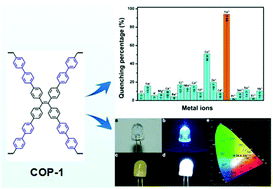A tetraphenylethylene-based covalent organic polymer for highly selective and sensitive detection of Fe3+ and as a white light emitting diode†
Abstract
A newly prepared tetraphenylethylene-based (TPE-based) covalent organic polymer (COP) named COP-1 exhibits high selectivity for sensing Fe3+ and the limit of detection (LOD) for Fe3+ is 0.42 μM, which is lower than the reported metal-free porous polymers. Furthermore, a WLED is fabricated and the CIE coordinates are (0.32, 0.33), very close to pure white light. The COP-1 shows potential applications in biosensors of Fe3+ and preparation of WLEDs.



 Please wait while we load your content...
Please wait while we load your content...